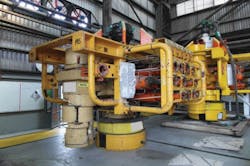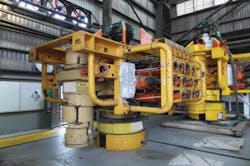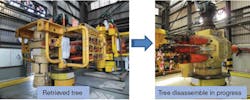Niyi Famuboni
Gary Ayenor
Ateke Abiye
Tawfiq Agbaje
Shell Nigeria Exploration & Production Co. Ltd.
Shell Nigeria Exploration & Production Co. Ltd. (SNEPCo) is recording unprecedented cost savings and efficiencies from its Bonga Phase 2 project through a new subsea tree refurbishment program. Cost reductions of up to 40% were made by accelerating the hardware availability through the refurbishment program. Additional gains were growing in-country capability through the expansion of facility infrastructure and the development of local engineers. The final result was the delivery of the first fully refurbished subsea production and water injection tree in Nigeria.
Bonga Phase 2
The Bonga main field is in OML 118 offshore Nigeria in water depths ranging from 996 m to 1,100 m (3,268 to 3,609 ft). It has been producing since 2007. SNEPCo (55%) operates the OML 118 license on behalf of the Nigerian National Petroleum Corp. in partnership with Esso Exploration and Production Deepwater Ltd. (20%), Total E&P Nigeria Ltd. (12.5%), and Nigerian Agip Exploration Ltd. (12.5%).
Bonga Phase 2 is an in-field wells delivery and hook-up project within Bonga main. The project calls for 43 wells to be developed progressively over 12 years, to maintain the Bonga FPSO’s throughput capacity.
The increasing costs of the subsea equipment required for deepwater projects combined with the global slump in oil prices prompted SNEPCo to review its value chain, and rapidly implement cost savings and production acceleration/optimization initiatives. Meanwhile, some of the subsea wells in the Bonga field are being suspended as having reached their economic field life (water cut greater than 90%). This would enable the access and retrieval of subsea trees for refurbishing.
The tree refurbishment program was found to be a key enabler for cost savings and for improving schedule delivery, hence value realization for Bonga Phase 2. The project schedule required the availability of subsea trees to deliver production within 14 months of the field development plan approval and the start-up of new wells thereafter every other three months, despite the fact that it takes about three years to manufacture a subsea tree. This demanded a hardware refurbishment program that would turnaround subsea trees in 12 months from the outset of the program, and then reduce this to eight months while maintaining SNEPCo’s quality standards and safety ambition of Goal Zero.
Additionally, the cost saving aspirations meant that, to be considered successful, the refurbishment efforts would also provide the required subsea hardware at cheaper costs compared to new ones. It also required the setting up of local capacity and developing human capital.
Tree refurbishment
The Bonga Phase 2 subsea trees are 5,000-psi MWP, 16-in. TR Mandrel, MD-H4 wellhead connector systems. They interface with the tubing hanger spool and tubing hanger on the wellhead and the lower riser and emergency disconnect package assemblies for workover operations. The trees have a 5-1⁄8-in. production bore with a 2-1⁄16-in. annulus bore complete with a similar sized 2-1⁄16-in. crossover valve integral to the master valve block. The trees weigh an estimated 32.5 metric tons (35.8 tons) with approximate dimensions of 3.43 x 3.45 x 4.57 m (135 x 136 x 180 in.).
The trees were originally manufactured to Product Specification Level (PSL) 3 - as described in API Specification 6A 20th Edition. Section J.2.3 of API 6A Annex J states that “equipment identified as originally manufactured to PSL 3 shall be repaired and remanufactured to Repair Level (RL) 1, RL 2, or RL 3.” The refurbishment strategy employed by the Bonga Phase 2 project team was to use the requirements listed for RL 1 as a base case for the scope of work. However, the collective requirements of RL 2 or RL 3 were to be adopted only if the final functionality tests and factory acceptance tests during RL 1 proved unsuccessful.
The technical assurance activities were planned in accordance with SNEPCo’s Discipline Controls and Assurance Framework (DCAF). The process required the identification of discipline standards (i.e. key deliverables of each discipline), the definition of the points at which these standards were applicable during the refurbishment program, and the identification of the level of technical authorization that would be required to sign-off a specific deliverable or decision.
The implementation of these requirements within the program was to be achieved via the development of a project control assurance plan with associated discipline standards and listed technical authorities (TAs).
Execution plan
In generating an execution plan, the SNEPCo project team recognized the importance of its interaction with the original equipment manufacturer (OEM) to deliver the refurbished trees. The execution strategy was to commence refurbishment activities immediately upon the arrival of each tree on site. The OEM was to initially carry out the inspection of each tree and provide a schedule and price quote for the refurbishment services that would return the full functionality of the tree to PSL 3, regardless of the targeted RL. This meant that the target turnaround for each tree would be based on the outcome of the initial inspection/test with potential requirements for a significant amount of procedural approvals, the expedited procurement of spares/replacement parts, and the immediate availability of test bays/technicians.
The inspection was to be conducted by means of visual inspection and functionality testing. Procedures that satisfy both stages were readily available in the form of a site receipt inspection procedure and a formal pre-operational test procedure, commonly known as a deck test.
Following the outcome of the deck test, a typical sequence of spares procurement, disassembly, and rebuild activities would ensue. This would ultimately lead to restoration of the tree’s full functionality.
It was identified early on in the project that the material traceability and conformance of a refurbished tree assembly could be cumbersome, particularly considering the use of a mix of old and new components.
As such, a dedicated Inspection and Test Plan (ITP) was developed by the OEM that mirrored SNEPCo’s quality management plan. The ITP identified controlling documents and defined the key inspection points during each phase of refurbishment - disassembly/repair, maintenance and assembly, and testing/purchased components. It also identified the key documents that would be made available at any given time if requested by any of the suppliers within the supply chain. These included everything from manufacturing work orders to completed manufacturing record books. Due to the crucial nature of the ITP, it was subjected to various iterations of the review process by both the OEM and SNEPCo.
A significant opportunity was also identified where progressive reviews of documentation to be handed over with the tree would be conducted. This would reduce the approval cycle of the final documentation dossier once the tree refurbishment was completed. The approval of this dossier has been known to take up to two months on certain projects, but the progressive reviews cut this down to no more than a week.
The first two subsea trees were recovered from the Bonga field in 2013 and 2014, respectively. Upon arrival at the OEM facility, the trees were subjected to a deck test.
From the test results, a survey report was generated, accompanied by a schedule that forecasted full turnaround time of more than one year - reflective of an RL 3 requirement per API 6A Annex J. This was because the majority of the valves on the tree, including both the production master valve and annulus master valve, were found as not being able to hold the required working pressure. Additionally, issues were observed with the insulation which is instrumental in ensuring the thermal retention of hydrocarbons for continuous flow.
The strip down of the tree was a meticulous process, which followed a procedure developed by the OEM but reflective of SNEPCo’s steer to retain and reuse as many parts as possible.
Each stripped item was carefully noted in a database that broke down the tree assembly into discrete major sub-assemblies. This allowed each item to be easily traceable to the sub-assembly (or assembly) that it was removed from. The database clearly stated the condition of each item, which was then reviewed by project and quality engineers who provided dispositions, categorizing them into a distinct type of repair requirement. These included re-weld, re-machine, scrap, use as-is, etc.
This database categorization formed the contents of the survey reports. This meant that resource requirements were immediately understood by manufacturing engineers who planned the required work orders (including manpower hours and resources).
Stripped down parts to be used “as-is” were subjected to a rigorous series of non-destructive examinations (NDEs). These included magnetic particle inspections, dye penetrant inspections, ultrasonic testing, hardness, and dimensional checks. Only those items that were found to be within the tolerance bracket of all NDE requirements were used, while a non-conformance report (NCR) was raised for all others. These NCRs were subjected to the typical review and disposition process, with the recommended rework executed and signed off by the designated parties from both SNEPCo and the OEM.
The rebuild and retest of the tree was carried out in a similar fashion as a new tree, albeit with known issues addressed and added functionalities effected. The dedicated assembly and test procedures were jointly developed by the OEM and SNEPCo and these reflected the latest industry requirements for a PSL 3 tree.
Challenges
The rebuild of the trees initially encountered some hiccups due to the lack of available spares and challenging lead times for delivery.
An extended standard replacement parts list was generated by the OEM in an effort to reduce the impact of long-lead spares. This list was defined as a robust list of spares required to return a tree to full functionality regardless of the outcome of the deck test. The list also took the approach of ordering most major sub-assemblies as whole units rather than ordering at the component level as was previously the case. For example, rather than ordering the bolts, nuts, and springs that make up an actuator assembly, the actuator assembly as a whole unit would be ordered. This list currently exists and would be utilized on all tree refurbishments after the sixth tree.
SNEPCo conducted an inspection of the OEM’s facility where the refurbishments were to take place, and found that stripping down only two trees (or one tree plus one of either LRP or EDP) would require the utilization of the entire floor space. This meant that optimization of the existing space to accommodate SNEPCo’s aggressive delivery schedule was required. This resulted in the conversion of a test bay to an assembly bay among other modifications.
Cost savings
Although fully exploiting the potential cost savings was a major driver for embarking on this refurbishment program, safety and technical integrity remained paramount. To achieve this, extensive discussions were held between project engineers, TAs, and Global SMEs for tree systems - from both the OEM and SNEPCo. This included the sharing of best practices from the Centre of Excellence, including the quick-fire implant of leading staff to make knowledge transfer efficient. A document was produced to provide a reference guide on how the scope of work was to be executed within the boundaries of the prevalent API 6A and 17D standards.
The document addressed performance requirements and standards of the subsea tree, mainly looking at the original design basis/functionality, welding and non-destructive tests, material traceability, and final acceptance tests (FAT). Additionally, the gap analyses conducted as part of the DCAF process resulted in six process safety excursions. These were all reviewed and accepted by the relevant Shell Global TAs, having satisfactorily demonstrated that risks to process safety were as low as reasonably practicable, and in instances to develop and deliver fitness for purpose studies. This was achieved through a careful analysis of data collected from both new and refurbished subsea trees. The acceptance of the excursions was crucial to the project as a rejection could have resulted in at least a 15-week delay to the scheduled first oil date (FOD).
The first refurbished tree was completed on schedule. This was seen as a significant schedule gain as a brand new subsea tree manufactured abroad would be delivered within 30 to 36 months.
A careful review of the survey reports helped to identify various additional components that could be reused rather than replaced, thus saving costs and time. Quotations went through several revisions. Ultimately, a final revision was agreed, which when added to the quoted manpower hours, amounted to about 60% of the cost of a new subsea tree, similar in configuration to one manufactured in the Americas or Europe.
By conducting activities locally in Nigeria, logistical costs were also significantly lower - another savings. The final quoted price for the refurbishment of a tree when compared to the 2015 escalated price of a similar tree refurbishment, which was conducted abroad for another Shell project in 2011, showed only a marginal difference. This meant that the refurbishment of trees could be executed locally in Nigeria for approximately the same price as it would cost to execute the program in the UK (a stark contrast to the often mentioned notion that Nigerian content requirement is an acceptable reason for increased costs).
SNEPCo began by placing purchase orders with the OEM in phases (stage 1 strip down, stage 2 rebuild, etc.). This was done to ensure robust monitoring of accrued costs. The first subsea tree completed FAT in April 2015 without exceeding the initial cost estimates.
In addition to cost savings, SNEPCo, its partners, and the OEM are working assiduously to improve the delivery time of the refurbished trees.
Furthermore, in order to sustain the technical integrity of the program, the excursions will continue to be supported by continuing to analyze data collected from other retrieved trees as more wells are suspended.
Conclusion
The first subsea tree was installed on schedule in May 2015 on the Bonga-51 well, and commenced well commissioning/start up in the same month. This was the first of its kind using a tree fully stripped down and refurbished locally in Nigeria, with all of its original functionality restored.
The second subsea tree has also completed full refurbishment and is installed on the Bonga-52 well. The well was successfully brought onstream delivering first hydrocarbons from the Bonga Phase 3 project, which was sanctioned in October 2014 with a target FOD of December 2015.
The successful full refurbishment of subsea trees in-country is a tremendous accomplishment in demonstrating localized operations through capacity development, technology transfer, and capital investment. It is worthy of note that throughout the refurbishment works, senior SNEPCo representatives, the OEM, and government regulatory bodies were visible at the OEM’s facility. With the delivery of the first fully refurbished subsea tree, SNEPCo, the OEM and the Nigerian government have fostered partnerships to strengthen and grow local capacity within the subsea oil and gas sector.
Overall, the subsea tree refurbishment program is firmly on track to achieve unprecedented percentage cost savings for the Bonga Phase 2 project while maintaining sound technical integrity and timely delivery.
Acknowledgment
This article is based on a paper presented at the Offshore West Africa Conference & Exhibition held in Lagos, Nigeria, Jan. 26-28, 2016.






